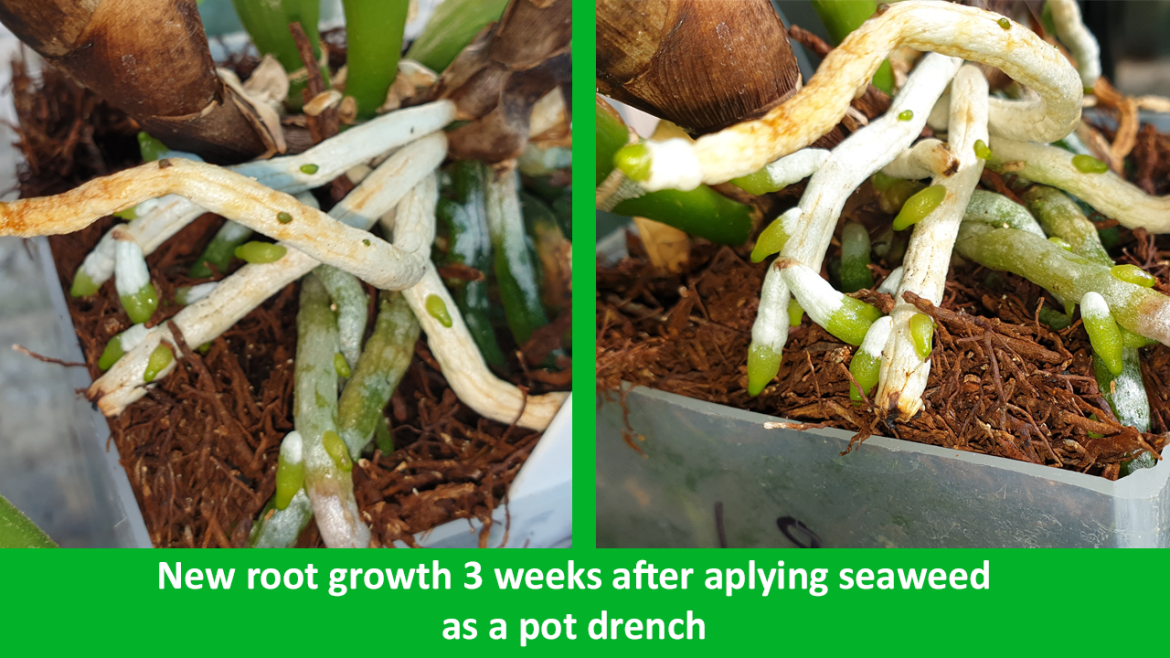How To Use Seaweed Concentrate On Plants
Incorporating a seaweed extract into your plant nutrition programme might be the one change that takes your plants from good to great. Plants that receive regular dose of seaweed tend to have superior vigor and health.
Plant enthusiasts often report one or more the following improvements to their plants from the regular application of a seaweed concentrate:
- Better root growth.
- Greening up of his plants.
- Better flower production.
- Improved flower colour.
- Stronger flower stems.
- Longer flower stems.
- Reduced incidence of pests and disease.
What is seaweed?
Seaweed is a marine plant or algae that grows in the ocean, rivers, lakes and other water bodies. Seaweed is constantly bathed in a soup of minerals and nutrients. Many of these minerals and compounds in the water are absorbed by the seaweed and provide a foundation for some of its amazing nutrient and plant growth-promoting properties. Eighty-four of the earth's basic elements have been identified in seawater as either macro or trace mineral ions.
What is in seaweed?
There are many elements and compounds found in seaweed that support plant growth, reproduction (flowering or fruiting) and health. Some of these include macro and micronutrients, proteins, vitamins, auxins, cytokinins, gibberellins, abscisic acid (ABA), carbohydrates, lipids, chelating agents plus many more.
How does seaweed work?
How seaweed works is difficult to define. It is my opinion that it is the synergistic effect of the bio-available nutrients, organic compounds and the plant growth regulators that send signals throughout the whole plant to stimulate biological and physiological responses in plants.
When applied as a soil drench, we know that seaweed feeds the biology in and around the root zone and creates a healthy environment for root growth, improving soil structure and convert nutrient into a form that plants can absorb.
What do the plant growth regulators do?
Seaweed contains many hormones and other growth-promoting compounds.
The 3 most common groups hormones we find in seaweed are:
- Auxins are produced in the apical meristem of plants, the “growing tip”. They are responsible for cell division, cell growth and differentiation. They can also influence the development of root elongation, the lateral branching of roots.
- Cytokinins are produced primarily in the roots they travel upwards through the xylem vessels and promotes lateral growth and slow down the symptoms of ageing and they can influence bud growth (lateral growth).
- Gibberellins generally short-lived and found in very low concentrations. Gibberellins determine stem growth and will influence flower and fruit development.

What about the minerals.
There are over 70 minerals in seaweed all present in micro or trace quantities. They are present in proportions which are suitable for plants. The fertilisers we use, which are made from various chemical compounds only contain a handful of the nutrients required. It, therefore, makes sense to include seaweed concentrate with your fertilisation programme to supply the missing nutrients.
Combined with a quality fertilizer, seaweed concentrate will provide almost all the nutrients required to support plant health, growth and flowering (reproduction).
Roots don't absorb bits of seaweed.
Plant can't absorb organic nutrients directly from the seaweed. In order for the nutrients to be made available to the plant, microbes need to breakdown organic matter and release inorganic compounds for the roots to absorb.
Seaweed acts as a food for microbes and they will flourish and get to work on the seaweed, releasing beneficial nutrients and compounds for the roots to absorb.
There are a whole lot of benefits to derive from having beneficial microbiology being active in the root zone and potting medium which I will not discuss in this article.
Why are micronutrients important for plants?
The micronutrients through their involvement in enzyme processes are part of a plant’s nutrients profile, regulating growth and development.
Enzymatic reactions are dependent upon the presence of certain micronutrients, which serve as catalysts. The micronutrients (Iron, Copper, Zinc, Magnesium, Boron, Manganese and Cobalt) serve as catalysts which activate the enzymes. Even though plants only require small amounts of these micronutrients, they are just as essential as NPK (Nitrogen, Phosphorus, Potassium) and in some cases even more. A lack of one of the above trace elements can upset the balance of one or more enzyme systems.
Although the yield of the crop may not suffer because of a trace element deficiency, the quality can be adversely affected.
The deficiency of one trace mineral may not always be corrected by the simple addition of this micronutrient. The perceived lack of one trace element may be attributed to an excess of another. An excessive amount of iron will often display symptoms associated with a manganese and phosphorus deficiency. Excess copper and zinc reduce iron’s availability. On grasslands, an excess of molybdenum produces a copper deficiency. It is therefore deemed prudent and sensible to provide a balanced micronutrient package, such as seaweed, rather than a single element.
The fertilisers we use only contain a handful of micro-nutrients. Including a monthly application of seaweed is a great way of supplying all the micronutrients required to optimise plant growth and health.
Other compounds found in seaweed
- Alginates help improve soil structure. Improved soil structure leads to increased aeration, improved water retention.
- Amino acids are used by plants for the production of proteins.
- Vitamins. Most seaweeds will contain the following in varying amounts. Vitamin A, B1, B2, B3, B5, B12, C, D, E, K, choline and carotene.
- Betaines aid plants to cope with stresses such as cold, heat, water and increases a plants tolerance to abiotic stress.
- Fucoidan helps plants protection for strong sunlight and harsh environments.
- Laminarin helps accelerate plant growth and elicits defence response in plants to reduce infection by various diseases.
- Mannitol increases trace element availability, increases a plants tolerance to salt and osmotic stress and has a role in a plants response to attack from pathogens; reducing biotic and abiotic stresses.
How often should I apply seaweed to my plants?
The general recommendation for plants is to apply a seaweed solution once a month. The reason for this is that seaweed contains growth hormones and frequent application can overstimulate cell production and cause flower and growth abnormalities.
If this does occur abstain from using seaweed for a couple of months and your plant will revert to growing normally again. This does not cause permanent damage.
Seaweed Application for Pot Plants
A. Pot Drench.
- The seaweed solution can be applied as a pot drench, on its own or combined with your fertiliser. Please check that your nutrient and seaweed are compatible before applying.
- Before and after repotting your plants drench the pot with your seaweed solution this will help reduce transplant shock and stimulate growth.
- For 4 to 6 weeks after repotting drench the pot with your seaweed solution to stimulate the plant into growing.
- If your plats have no roots or very little root structure, soak them in a solution of seaweed for 24 hours before repotting. The hormones in the seaweed may help stimulate the roots to grow.
B. Foliar Application
- Apply the seaweed as a foliar spray to both the top and underside of the leaves. This should not be done more than once a month.
- You can include a wetting agent or a drop or two of dishwashing soap to help spread the solution evenly on the leaf surface.
- When applying a foliar spray all that is required is a light covering of the leaf and stem. Applying too much may result in the accumulation of seaweed in plant cavities such as new growths, flower sheaths, leaf surfaces, etc. The seaweed in water is an organic compound and if left too long in plant cavities, it will start to break down and cause rot, attracting all sorts of organisms which may be harmful to your plant.
- Regarding point 3 above apply foliar spray cautiously in winter and cooler months. During the warmer growing months, this should not be a concern
My best advice.
I encourage you to experiment and find what application method, rate and frequency works for your growing practices.
Which seaweed product do we recommend?
Not all seaweeds are created equal. Manufacturing and extraction processes affect the quality of the seaweed concentrate. Some seaweed products are a by-product of a manufacturing process and lack some of the vital ingredients.
We use and recommend the BioPower range or Ocean Organics Seaweed Concentrate seaweed products.
BioPower is made from Ascophyllum nodosum using biological fermentation, low temperature, and negative pressure manufacturing process. This process arguably provides a high concentration of beneficial compounds.
Return to the Articles Page
Disclaimer:
Please recognize that seaweed is not a fertiliser as defined by classical science but rather it is to be considered as a growth enhancer or as a plant growth stimulant. Just like we take vitamins to improve our health and wellbeing, using seaweed as a drench or as a foliar spray helps improve or stimulate plant growth, reproduction and health.
Used alone, it does not contain sufficient quantities of nutrients to support plant growth and health.
